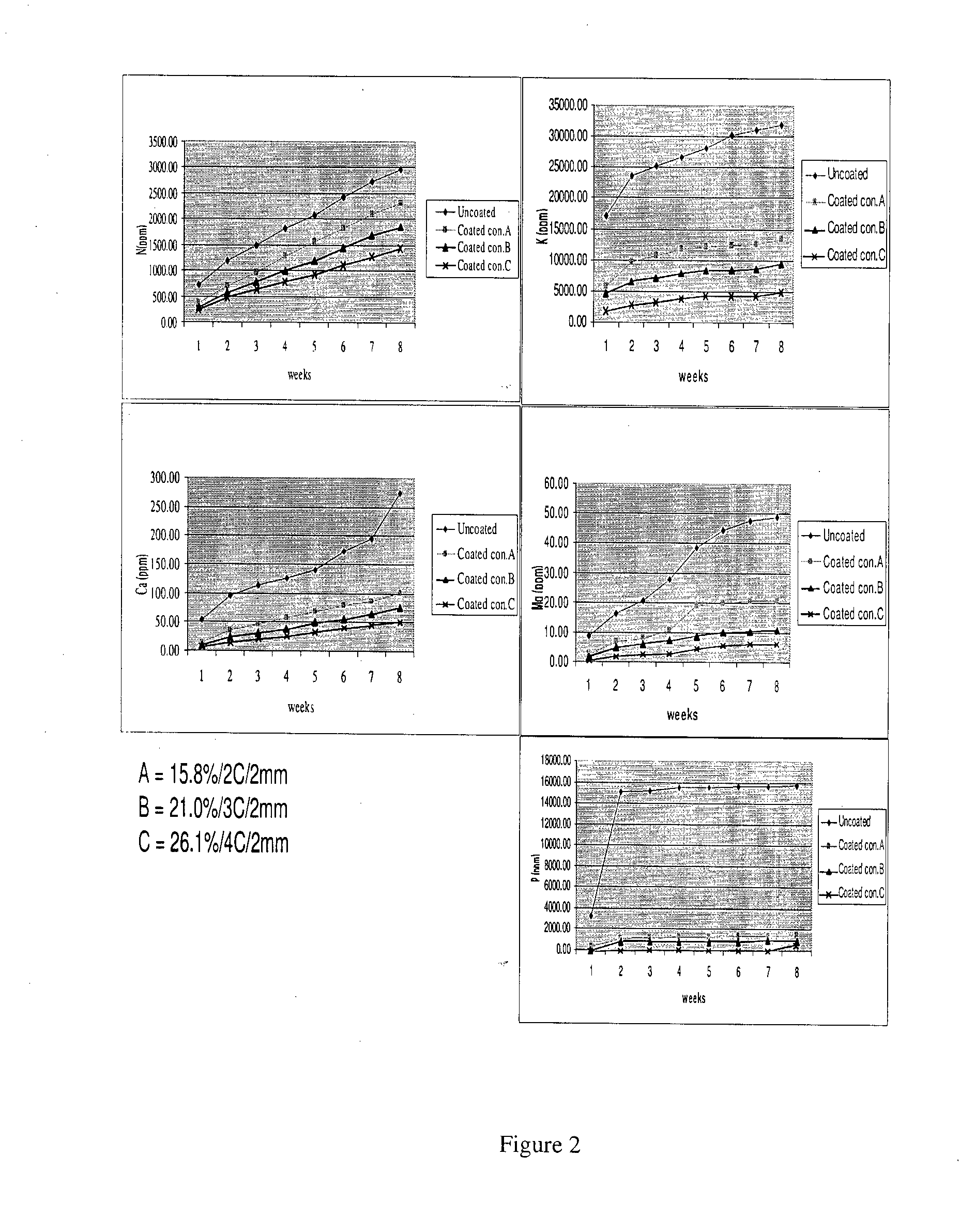Controlled-Release Fertilizer
a technology of controlled release and fertilizer, which is applied in the direction of organic fertilisers, fertilizer mixtures, layered/coated fertilisers, etc., can solve the problems of uncoated fertilizers forming cake, affecting the quality of organic fertilizers, so as to reduce the viscosity of polyols or coating materials, prevent agglomeration of fertilizers, and facilitate the application of coatings
- Summary
- Abstract
- Description
- Claims
- Application Information
AI Technical Summary
Benefits of technology
Problems solved by technology
Method used
Image
Examples
example 1
[0063]The materials are fertilizer particles, polyol, polyisocyanate, palm oil methyl ester, catalyst and filler. The fertilizer particles used are a palm-based bio-fertilizer prepared by Malaysian Palm Oil Board.
[0064]The natural oil-based polyol is of palm oil obtained by the reaction between an alcohol and an epoxidized palm oil, having an OH value of about 70-90 mg KOH / g sample, equivalent weight of 801.43-623.33 and a viscosity of 600-800 cP at 25° C.
[0065]The polyisocyanate is a polymethylene poly(phenylisocyanate) containing about 66% diphenylmethane diisocyanate monomers having a 2,4′-isomer content of about 19% by weight, based on total weight of the polymethylene poly(phenylisocyanate), 345 by weight of higher functionality homologs and having an overall isocyanate group content of about 32.3% and a functionality of about 2.3.
[0066]The palm oil methyl ester is supplied by Cognis Oleochemicals (M) Sdn. Bhd. The catalyst is a solution of 33% triethylenediamine and 67% diprop...
example 2
[0071]The slow release properties of the encapsulated fertilizer particles in Example 1 shall be examined. Each fertilizer sample of about 15 g is placed on filter paper and moisten by 50 g of water on a daily basis. The filtered water is collected and stored at room temperature in a closed glass container. After a week, the release of nutrients is determined by testing the filtered water.
[0072]The sample ID of uncoated, A, B and C as in Table 1 are respectively referred as a bio-fertilizer with 0%, 15.82%, 21% and 26% polyurethane coating, as based on the total weight of the encapsulated fertilizer particles. The result of the cumulative nitrogen release in ppm for the uncoated and coated palm-based potassium bio-fertilizer is indicated in Table 2,
TABLE 2WeekSample ID12345678Uncoated720.591199.991496.771809.122088.322428.652736.352960.13A363.63710.86961.051273.401552.601809.012107.382312.51B302.32593.69804.281014.071223.861447.641699.391876.55C254.51484.49657.76802.29942.151109.981...
example 3
[0076]The materials comprising polyol, methyl ester derivative and polyisocyanate are used according to the stated amount in Table 1 above and the fertilizer samples are produced following the method under Example 1. The bio-fertilizer particles used herein are 100 g of a preheated palm-based bio-fertilizer.
[0077]The encapsulated bio-fertilizer granules from each sample are tested of the slow release properties as compared to the uncoated one. About 20 g of fertilizer pellets are placed on peat or sand medium and moisten with 100 g of water on a daily basis. The filtered water is collected and stored at room temperature in a closed glass jar. After one week, the release of the nutrients is determined by testing the filtered water.
[0078]The tests are carried out for 8 weeks, whereby the nutrients released are measured on weekly basis as shown in FIG. 1 and FIG. 2. The sample ID of uncoated, A, B and C respectively are referred as a bio-fertilizer having 0%, 15.82%, 21% and 26% polyur...
PUM
| Property | Measurement | Unit |
|---|---|---|
| viscosity | aaaaa | aaaaa |
| viscosity | aaaaa | aaaaa |
| viscosity | aaaaa | aaaaa |
Abstract
Description
Claims
Application Information
 Login to View More
Login to View More - R&D
- Intellectual Property
- Life Sciences
- Materials
- Tech Scout
- Unparalleled Data Quality
- Higher Quality Content
- 60% Fewer Hallucinations
Browse by: Latest US Patents, China's latest patents, Technical Efficacy Thesaurus, Application Domain, Technology Topic, Popular Technical Reports.
© 2025 PatSnap. All rights reserved.Legal|Privacy policy|Modern Slavery Act Transparency Statement|Sitemap|About US| Contact US: help@patsnap.com


